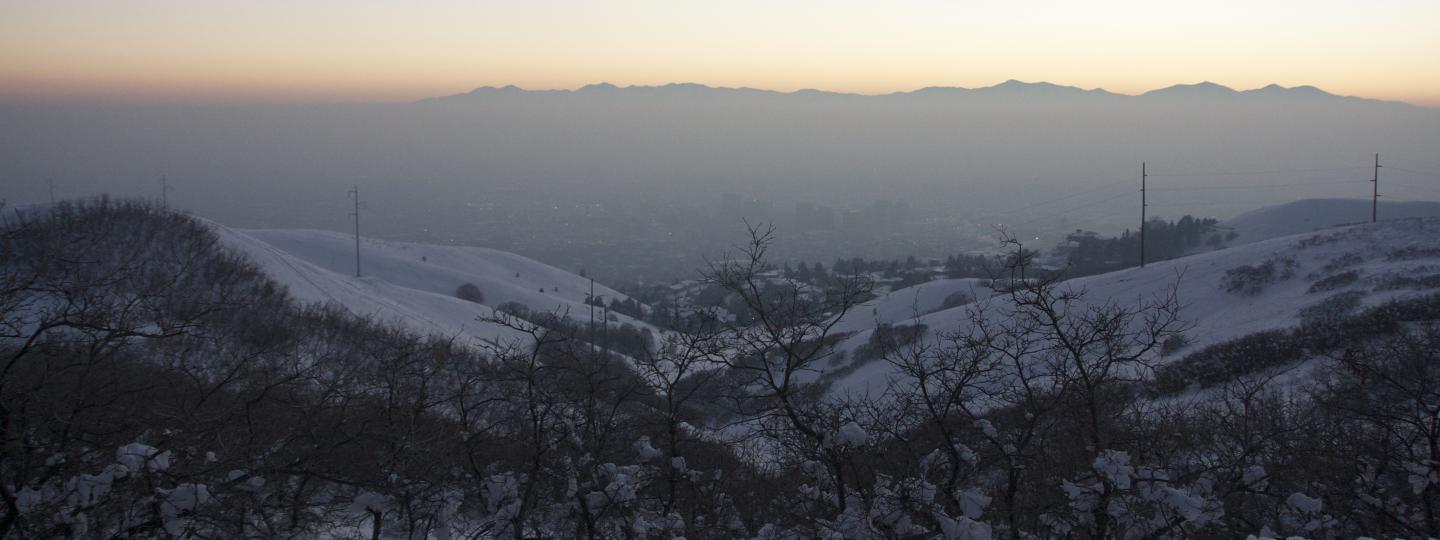
Credit: University of Utah Health
Air quality has been associated with numerous adverse health outcomes from asthma to pre-term birth. Researchers at University of Utah Health found women living along the Wasatch Front — the most populous region in the state of Utah — had a higher risk (16 percent) of miscarriage following short-term exposure to elevated air pollution. The results are available online on December 5 in the journal Fertility and Sterility.
“Not being from Salt Lake originally, I noticed a pattern in the relation to air quality and pregnancy loss,” said Matthew Fuller, M.D., assistant professor of Surgery at U of U Health and senior author on the paper. “I knew this was an understudied question so we decided to dig deeper.”
Fuller joined University of Utah research analyst Claire Leiser on a retrospective study consisting of more than 1,300 women (54 percent Caucasian, 38 percent Hispanic, and other/missing 8 percent; average age 28 years). The women in the study sought help at the U of U emergency department following a miscarriage (up to 20-weeks gestation) between 2007 to 2015.
The team examined the risk of miscarriage during a three- or seven-day window following a spike in the concentration of three common air pollutants: small particulate matter (PM 2.5), nitrogen dioxide and ozone. The study excluded women who lived outside Utah.
“We are really only seeing the most severe cases during a small window of time,” said Leiser, first author on the paper. “These results are not the whole picture.”
Leiser notes the results suggest there could be an increased risk for an individual. Their research only captured women who sought help at an emergency department at one hospital in the region. It does not account for women who may have sought outpatient care through their obstetric or primary care providers.
The team found a slight increased risk in miscarriage for women exposed to elevated levels of nitrogen dioxide (16 percent for 10 ppb increase during the seven-day window). Although small particulate matter does track with nitrogen dioxide, these results did not significantly associate with an increased risk of miscarriage.
“While we live in a pretty unique geographic area, the problems we face when it comes to air pollution are not unique,” said Fuller. “As the planet warms and population booms, air pollution is going to become a bigger problem not only in the developing world but across the United States.”
The Wasatch Front experiences short-periods of poor air quality, primarily during the winter months, when inversions trap pollutants close to the ground (for the 7-day window: PM2.5min= 0.3?g/m3; PM2.5max= 73.0 ?g/m3; O3 min= 4 ppb; O3 max= 80 ppb; NO2 min= 0.5ppb; NO2 max= 65ppb). The researchers tracked air quality by zip code, establishing six designated air basins within the Wasatch Front. They compared air quality in each basin to their patients’ outcomes.
The team conducted a case cross-over study that estimated a woman’s risk of miscarriage multiple times in a month where air pollution exposure varied. This approach removed other risk factors, like maternal age, from the study. The scientists were unable to ascertain the age of the fetus at the time of the miscarriage and were unable pinpoint a critical period when the fetus may be most vulnerable to pollutants.
“The results of this study are upsetting, and we need to work together as a society to find constructive solutions,” Fuller said.
Fuller recommends women speak with their doctor about any health concerns. Women can manage the risk by using a N95 particulate respirator face mask to filter out pollutants or avoid outdoor physical activity on poor air quality days. Women can also use filters to lower indoor pollution and, if possible, time conception to avoid seasonal episodes of poor air quality.
###
Leiser and Fuller were joined by Heidi Hanson, Kara Sawyer, Jacob Steenblik, Troy Madsen, James Hotaling, Yetunde Ibrahim and James VanDerslice at U of U Health; Ragheed Al-Dulaimi at Hurley Medical Center, Flint, Mich. and Karen Gibbins at Oregon Health and Science University, Portland, Ore. Their article, titled Acute Effects of Air Pollutants on Spontaneous Pregnancy Loss: A Case-Crossover Study, appears online in the December 5 issue of the journal Fertility and Sterility.
The work was funded through grants from the National Institutes of Health and the Consortium for Families & Health Research.
University of Utah Health provides leading-edge and compassionate medicine for a referral area that encompasses 10 percent of the U.S., including Idaho, Wyoming, Montana and much of Nevada. A hub for health sciences research and education in the region, U of U Health touts a $356 million research enterprise and trains the majority of Utah’s physicians and more than 1,250 health care providers each year at its Schools of Medicine and Dentistry and Colleges of Nursing, Pharmacy and Health. With more than 20,000 employees, the system includes 12 community clinics and four hospitals. For eight straight years, U of U Health has ranked among the top 10 U.S. academic medical centers in the rigorous Vizient Quality and Accountability Study, including reaching No. 1 in 2010 and 2016.
Media Contact
Stacy W. Kish
[email protected]
801-587-2596
News source: https://scienmag.com/




